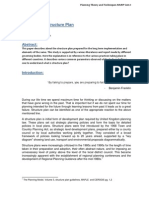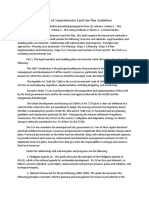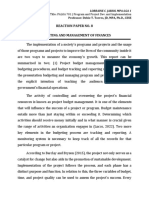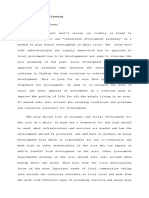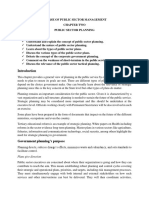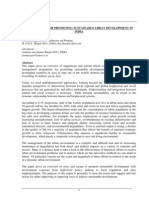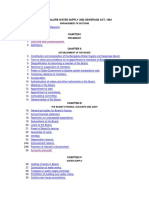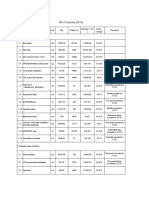Chapter 1 PLANNING PROCESS
Chapter 1 PLANNING PROCESS
Uploaded by
100forplatesCopyright:
Available Formats
Chapter 1 PLANNING PROCESS
Chapter 1 PLANNING PROCESS
Uploaded by
100forplatesOriginal Description:
Copyright
Available Formats
Share this document
Did you find this document useful?
Is this content inappropriate?
Copyright:
Available Formats
Chapter 1 PLANNING PROCESS
Chapter 1 PLANNING PROCESS
Uploaded by
100forplatesCopyright:
Available Formats
Chapter 1 PLANNING PROCESS 1
Chapter 1
1.1 THE PLANNING PROCESS
For the next six years, 2018 – 2023, the City Government of Angeles shall be
administered using a framework where government actions in terms of programs,
projects and policies to be adopted and implemented shall originate from a
comprehensive study of the various development challenges confronting the City. As the
primary objective of the process, Comprehensive Development Planning is expected to
capture the genuine needs, aspirations and interests of the Angeleños, whether as
groups or as individuals. Towards this end, a participatory process was undertaken to
ensure that the programs and projects and the policies that will be adopted are truly
reflective of popular sentiment.
1.2 LEGAL MANDATE
The governing law for all Local Government Units (LGUs), the Local Government Code of
1991 or R.A. No. 7160, enjoins all LGUs, from the Barangay up to the Province or Highly-
Urbanized City level, to prepare Integrated and Comprehensive Multi-Sectoral Plans.
Section 109 of the LGC expressly mandates LGUs to undertake comprehensive planning.
1.3 SECTORAL CONCERNS
Sectoral concerns and issues identified in this Plan document were drawn heavily from
the Angeles City updated Area Ecological Profile (AEP). While titled “Profile”, the AEP
goes beyond profiling because it contains an analysis of the development problems
besetting the City. Validated in public consultations with the various stakeholders of the
City, these problems were defined to ensure correctness of the response-interventions
expected from the City. Said interventions will be concretized through Programs,
Projects and Policies.
COMPREHENSIVE DEVELOPMENT PLAN 2018 – 2023
Chapter 1 PLANNING PROCESS 2
Below are the major Sectoral Concerns intended to be magnified, fleshed out and which
resolution requires precise employment of resources by the Angeles City Government.
1.3.1 Social Development
This section of the CDP is concerned with advancing the well-being of the local
population. They are the essence of development and for whom and by whom the LGU
exists and functions. Measures for upgrading social services that respond to the needs of
the people for achieving better quality of life and improving participation in local
development are tackled in this sectoral plan.
1.3.2 Economic Development
Good governance and a sound economy are complementary of each other. Good
governance is necessary to be able to provide the resources the government needs to
keep it functioning and to create the environment that will be favorable to job-
generation for the people in the community. On the other hand, these resources will
come from a sound economy which is not possible without good governance.
The Economic Development chapter of the CDP, hence, provides a description of how
the LGU shall provide the environment for stimulating the growth of the local economy
and how the people will participate in and benefit from this growth. The sector plan also
includes measures for tapping into the potential and existing assets of the local area to
create opportunities for growth of economic activities.
1.3.3 Environmental Management
Section 16 or the General Welfare Clause of the LGC expressly states the responsibility of
every local government to ensure and support, among others, the promotion of health
and safety of the people and the enhancement of their right to a balanced ecology.
Thus, considering this, the Environmental Management chapter of the CDP embodies
the local government’s plan for ensuring the sustainable development of the City. This
COMPREHENSIVE DEVELOPMENT PLAN 2018 – 2023
Chapter 1 PLANNING PROCESS 3
includes measures for ensuring that development shall not cause harm to both people
and the environment, and that protection or preservation of the quality of the
environment for the people’s enjoyment are pursued alongside with the pursuit of
physical and economic development.
1.3.4 Infrastructure Development
This component of the CDP identifies infrastructure needed to support or is essential in
promoting local economic development and ensuring public health and safety as well as
the comfort and convenience of citizens. Such programs include, among others, the
construction and maintenance of roads and bridges, water supply systems, public
markets, schools, health centers or hospitals, drainage and sewerage, and flood control
and the laying down of an efficient and appropriate pattern of development deemed to
encourage growth across areas of the City.
1.3.5 Institutional Development
Good governance lays the foundation for the sustainable development of the local area.
It provides the momentum to development and ensures that such shall be achieved as it
is the duty and responsibility of the local government to manage the affairs of its
territorial jurisdiction, more so, its growth and development for the well-being of its
people. This component, thus, of the CDP, focuses on enhancing the capability of the
bureaucracy and the local officials to plan and manage the City’s development and to
effectively and efficiently deliver the public goods and services expected of it to provide
and carry out. This includes, among others, programs for improving the structure and
staffing of the local government bureaucracy, better fiscal management, enhancing
stakeholder participation in the development process, and strengthening executive and
legislative tie-up.
COMPREHENSIVE DEVELOPMENT PLAN 2018 – 2023
Chapter 1 PLANNING PROCESS 4
1.4 COMPREHENSIVE DEVELOPMENT PLANNING PROCESS
Described here are the steps observed in the preparation of the Angeles City
Comprehensive Development Plan, to wit:
1.4.1 Situational Analysis/Problem Identification
Interview with Key Informants
The Planning Team’s Sectoral Technical Working Groups (TWGs) created to do the Plan
Preparation were time and again convened to ascertain the circumstances surrounding
the City’s development issues and concerns. All department heads and their respective
technical staff provided incisive insights through their experiential views and
commentaries. These were considered in the definition of said development issues and
concerns. It is also in this phase that existing plans were revisited together with the
City’s vision. This will help the planning team in identifying and profiling the existing
sectoral and thematic plans for their responsiveness to recent mandates and prevailing
situations and can be incorporated in the CDP.
Consultations with Various Development Stakeholders
Consideration of the socio-economic issues or challenges facing the whole spectrum of
governance of the City including the smallest political unit, the barangays, was given
forum through the conduct of public consultations. Representatives from all sectors –
national government and civil society together with City government officials and
employees were gathered in a series of workshops in the determination of the problems
and its resolutions.
Public consultations served as a venue to generate inputs from various stakeholders as
to the characterization of the development concerns and issues – why they exist and the
reasons for their persistent recurrence. Development strategies and interventions
(programs, projects) needed to be implemented within the six-year plan period were
identified. Said public consultations were held on June 16, June 20, June 21, June 23,
COMPREHENSIVE DEVELOPMENT PLAN 2018 – 2023
Chapter 1 PLANNING PROCESS 5
and July 5, 2017 for the different sectors- Economic Development, Environmental
Management, Infrastructure Development, Institutional Development, and Social
Development.
The nexus of Problem and Interventions (Programs, Projects and Policies) Identification
has cast in stone the unity, coherence and effectiveness of the Plan in addressing the
City’s development concerns and issues towards inclusive growth.
1.4.2 Goal Formulation
Using the problem/inter-connected problems and their characteristics as premise the
desired future condition under a problem-less setting was envisioned. Merged into a
cohesive and unified response statement, each Goal formulated describes the desired
future state or scenario where the problem/s shall have been eliminated. Under the
usual planning process, the Goals formulated are considered as inter-sectoral in nature,
broader, more comprehensive and representative of multi-faceted development
perspective.
The compilation of Goals, when achieved shall help attain the long-range Vision of the
City.
1.4.3 Objective Formulation
Ideally, an Objective is on a one-on-one correspondence with a Problem. Pure and
simple, like the Goal, it is a condition when said problem shall already have disappeared.
While an objective is more detailed and more focused than a Goal, it is limited and
narrower in scope. An Objective is expectedly, the direct (positive) opposite of every
Problem analyzed. A compilation of related objectives will contribute to the attainment
of a Goal.
1.4.4 Target-Setting
COMPREHENSIVE DEVELOPMENT PLAN 2018 – 2023
Chapter 1 PLANNING PROCESS 6
A technical analysis enhanced by insights from the stakeholders, and the past or
historical values of relevant Outcome Indicators were closely looked into and considered
in the quantification of targets within the plan period. An analysis of problems being
addressed to include those related to plan implementation was considered in the
process. Consideration of the causes of problems and the performance of historical data
was directed at ensuring that the targets set within the plan period are realistic and
attainable.
1.4.5 Strategy Formulation
Ways on achieving Goals, Objectives and Targets were identified in this stage. Strengths
and Opportunities (SOs) were surfaced and validated through the public consultations.
Strategy Statements were technically crafted to ensure that they would be pushed hard
on meeting the set Objectives and Targets and minimize the anticipated adverse effects
from identified Weaknesses and Threats (WTs). The value of an intensive Problem
Identification and Analysis was appreciated in this respect. This stage will input into the
Project and Policy Identification process.
COMPREHENSIVE DEVELOPMENT PLAN 2018 – 2023
You might also like
- Handbook On The Participation of The CSO in The Local Budget ProcessDocument44 pagesHandbook On The Participation of The CSO in The Local Budget ProcessDBM CALABARZON93% (14)
- Notes Transpiration ICSE Class 10 BiologyDocument6 pagesNotes Transpiration ICSE Class 10 BiologyAyush Pandey100% (1)
- 7 Types of Urban Planning Concepts ExplainedDocument7 pages7 Types of Urban Planning Concepts ExplainedTanveerNo ratings yet
- Strategizing For Integrated Approach in The Local Government Contemporary Issues in Planning and ManagementDocument8 pagesStrategizing For Integrated Approach in The Local Government Contemporary Issues in Planning and ManagementChristine Mhay A. Torres - ReymanNo ratings yet
- Developmental Plan and Its TypesDocument19 pagesDevelopmental Plan and Its TypesRajat NainwalNo ratings yet
- Community Strategic PlanningDocument6 pagesCommunity Strategic PlanningRachelNo ratings yet
- Ar 4271 - RSW-FN-04Document3 pagesAr 4271 - RSW-FN-04ARMENIA RUTH DUENo ratings yet
- Structure Plan PDFDocument8 pagesStructure Plan PDFAbhishek Jani100% (1)
- Victoria - CDP - Final Draft - Dec.22.21Document122 pagesVictoria - CDP - Final Draft - Dec.22.21Jeffrey LoraNo ratings yet
- Long Term PlanningDocument6 pagesLong Term PlanningAnchal kumariNo ratings yet
- Key Technical Areas For: Developing Infrastructure ServicesDocument56 pagesKey Technical Areas For: Developing Infrastructure Servicesrajesh0005No ratings yet
- LGU Competency Assessment Faci GuideDocument11 pagesLGU Competency Assessment Faci GuideFelicitas RelatoNo ratings yet
- Reforms in Urban Planning and Development Process: Case of Uttar Pradesh, IndiaDocument8 pagesReforms in Urban Planning and Development Process: Case of Uttar Pradesh, Indiasandeep200789No ratings yet
- RG Unit 6Document21 pagesRG Unit 6Gemechu AbrahimNo ratings yet
- Comprehensive Development Plan For LGUDocument4 pagesComprehensive Development Plan For LGUNeil Geraldizo DagohoyNo ratings yet
- Theory and Science of Public Administration - MUNIERA 1Document23 pagesTheory and Science of Public Administration - MUNIERA 1Jotham ShumbaNo ratings yet
- The BDPDocument48 pagesThe BDPMpdco DipaculaoNo ratings yet
- Mabalacat City CDPDocument187 pagesMabalacat City CDPjorrymar3No ratings yet
- CDP Toolkit Book Second Revised 2012 As PrintingDocument100 pagesCDP Toolkit Book Second Revised 2012 As PrintingLiju MathewNo ratings yet
- Development PlanDocument8 pagesDevelopment PlanuyunamanNo ratings yet
- Concept Note OneDocument7 pagesConcept Note OneDanny MgenyandaNo ratings yet
- Public Administration Unit-71 Scope and SignificanceDocument10 pagesPublic Administration Unit-71 Scope and SignificanceDeepika SharmaNo ratings yet
- Kerala Perspective Plan 0Document5 pagesKerala Perspective Plan 0ar nedungadiNo ratings yet
- Chapter 1Document18 pagesChapter 1HanaNo ratings yet
- Integrated Develoment Plan PUB3718Document6 pagesIntegrated Develoment Plan PUB3718Tsholofelo Majipos StlhanohNo ratings yet
- Development Planning: Meaning, Nature and Scope What Is Development?Document3 pagesDevelopment Planning: Meaning, Nature and Scope What Is Development?Monisha LingamNo ratings yet
- NEBIIIIIIIIIIIDocument6 pagesNEBIIIIIIIIIIIKenedy Eshetie (ivan)No ratings yet
- Towards Strategic Planning Implementation For Egyptian CitiesDocument14 pagesTowards Strategic Planning Implementation For Egyptian CitiesIEREKNo ratings yet
- 2008 BOM - FinalManuscriptDocument283 pages2008 BOM - FinalManuscriptAriel AbisNo ratings yet
- Concept of Regional PlanningDocument4 pagesConcept of Regional PlanningPankaj Pharswan100% (1)
- 1Document92 pages1Girma GeletNo ratings yet
- Machinary For Planning - Planning Commission - NDCDocument13 pagesMachinary For Planning - Planning Commission - NDCRaovarinder SinghNo ratings yet
- Economic Development Strategic PlanningDocument8 pagesEconomic Development Strategic PlanningArsdy NovalentioNo ratings yet
- Legal Instruments & Guiding Frameworks For Planners: A ReportDocument7 pagesLegal Instruments & Guiding Frameworks For Planners: A ReportbarkhabaharNo ratings yet
- 1 Chapter 1 Overview of Project Program and Development Plan FinalDocument18 pages1 Chapter 1 Overview of Project Program and Development Plan Finaltsi55derNo ratings yet
- Clup OverviewDocument46 pagesClup Overviewjbcruz2No ratings yet
- 92438-Municipal - Growth - Readiness - Checklist - Final - July - 2015 2Document13 pages92438-Municipal - Growth - Readiness - Checklist - Final - July - 2015 2MerdzNo ratings yet
- Synthesis of Comprehensive Land Use Plan Guidelines 1Document5 pagesSynthesis of Comprehensive Land Use Plan Guidelines 1Jho Harry ForcadasNo ratings yet
- 8 JARIOL - REACTION PAPER - Budgeting and Management of FinancesDocument3 pages8 JARIOL - REACTION PAPER - Budgeting and Management of FinancesLorraine JariolNo ratings yet
- Comprehensive Planning TemplateDocument21 pagesComprehensive Planning TemplateErnan BaldomeroNo ratings yet
- FILE 4 Local Development PlanningDocument3 pagesFILE 4 Local Development PlanningKnotsNautischeMeilenproStundeNo ratings yet
- SatturDocument180 pagesSatturjoearunrajaNo ratings yet
- Notes IDocument12 pagesNotes IShourya TewariNo ratings yet
- Legal Framework For Regional Planning Authority-1Document23 pagesLegal Framework For Regional Planning Authority-1Ainul Jaria MaidinNo ratings yet
- Lecture Notes - Intro 2024Document6 pagesLecture Notes - Intro 2024manzjojo0No ratings yet
- 4) Different Types of PlanDocument14 pages4) Different Types of PlanReeba BennyNo ratings yet
- Chapter Aims: Course of Public Sector Management Chapter Two Public Sector PlanningDocument11 pagesChapter Aims: Course of Public Sector Management Chapter Two Public Sector PlanningAbdulphatah Mohamed IbrahimNo ratings yet
- SC08006FU1Document11 pagesSC08006FU1Abdul OGNo ratings yet
- An Overview For Promoting Sustainable Urban Development in IndiaDocument9 pagesAn Overview For Promoting Sustainable Urban Development in IndiaSandeep NayarNo ratings yet
- Earthquake Risk ReductionDocument3 pagesEarthquake Risk ReductionBharti GoyalNo ratings yet
- Land Pooling Technique in IndiaDocument11 pagesLand Pooling Technique in IndiaAshok NirmanNo ratings yet
- An Overview For Promoting Sustainable Urban Development in IndiaDocument9 pagesAn Overview For Promoting Sustainable Urban Development in IndiaSandeep NayarNo ratings yet
- DPA 507 NEDA and Its ProcessDocument4 pagesDPA 507 NEDA and Its ProcessBatang MalolosNo ratings yet
- Urban Design PolicyDocument23 pagesUrban Design Policyदीपक दासNo ratings yet
- Towards Strategic Planning Implementation For Egyptian CitiesDocument16 pagesTowards Strategic Planning Implementation For Egyptian CitiesIEREKPRESSNo ratings yet
- Government Planning Organizations and Environmental PlanningDocument17 pagesGovernment Planning Organizations and Environmental PlanningPeña ,Khlarenze G.No ratings yet
- Staying Small SMEDocument9 pagesStaying Small SMEShailendra KelaniNo ratings yet
- Catalysing Young Agri-Entrepreneurs' Investments and Ensuring Their Sustainability: Strategic Planning ToolFrom EverandCatalysing Young Agri-Entrepreneurs' Investments and Ensuring Their Sustainability: Strategic Planning ToolNo ratings yet
- Healthy and Age-Friendly Cities in the People's Republic of China: Proposal for Health Impact Assessment and Healthy and Age-Friendly City Action and Management PlanningFrom EverandHealthy and Age-Friendly Cities in the People's Republic of China: Proposal for Health Impact Assessment and Healthy and Age-Friendly City Action and Management PlanningNo ratings yet
- B Table of ContentsDocument5 pagesB Table of Contents100forplatesNo ratings yet
- Sanitation in Floating Communities in Cambodia Report For MRD Small SizeDocument33 pagesSanitation in Floating Communities in Cambodia Report For MRD Small Size100forplatesNo ratings yet
- Minimising-Damage TSUNAMIDocument3 pagesMinimising-Damage TSUNAMI100forplatesNo ratings yet
- Colliers Bulacan 2021 Residential JB 03172022 BO EditsDocument4 pagesColliers Bulacan 2021 Residential JB 03172022 BO Edits100forplatesNo ratings yet
- Irrigation Notes PAES 603 611Document8 pagesIrrigation Notes PAES 603 611love17yahoocomNo ratings yet
- Ahmedabad - Gandhinagar Twin City, Gujarat: P.R.Gupte, CGWB, AhmedabadDocument11 pagesAhmedabad - Gandhinagar Twin City, Gujarat: P.R.Gupte, CGWB, Ahmedabaddeepansha tyagiNo ratings yet
- Perhitungan Hydraulic Head Dan Kontur Hydraulic HeadDocument10 pagesPerhitungan Hydraulic Head Dan Kontur Hydraulic HeadLicia AudinaNo ratings yet
- L15 - HoldernessDocument9 pagesL15 - HoldernessotwadiNo ratings yet
- Tiny Dungeon 2E Fenmire SettingDocument17 pagesTiny Dungeon 2E Fenmire SettingJohn Cross50% (2)
- Tut#3Document1 pageTut#3relapsemrNo ratings yet
- 03 DILG Bridge HydraulicsDocument31 pages03 DILG Bridge HydraulicsHarry BasadaNo ratings yet
- lab exercise 04Document2 pageslab exercise 04Tin LumantasNo ratings yet
- A Technical Manual For Small-And Medium-Scale Coastal Fish Farms in Southeast AsiaDocument28 pagesA Technical Manual For Small-And Medium-Scale Coastal Fish Farms in Southeast AsiajeffreyNo ratings yet
- BWSSB 36 of 1964 (E)Document57 pagesBWSSB 36 of 1964 (E)shamalaksNo ratings yet
- Tropical Deciduous ForestDocument2 pagesTropical Deciduous Forestbot bboottNo ratings yet
- Sanya Airport, ChinaDocument28 pagesSanya Airport, ChinaAlya WaleedNo ratings yet
- 26 Florida's CommunitiesDocument284 pages26 Florida's CommunitiesAllan EPNo ratings yet
- Statement of Work Exterior Painting 22Document22 pagesStatement of Work Exterior Painting 22iskidrowNo ratings yet
- 1.BOQ and Details of BOQ1Document5 pages1.BOQ and Details of BOQ1Tari IslamNo ratings yet
- ISO 8124-12 MicrobiologicalDocument14 pagesISO 8124-12 Microbiologicaltsing takNo ratings yet
- DROUGHTSDocument10 pagesDROUGHTSMarvin BenedictoNo ratings yet
- Rundown Imdg Batch 10. SurabayaDocument2 pagesRundown Imdg Batch 10. SurabayaFarah ChannelNo ratings yet
- Kkip Masterplan.Document1 pageKkip Masterplan.yuszriNo ratings yet
- Environmental Problems and Mitigating MeasureDocument37 pagesEnvironmental Problems and Mitigating MeasureTimothy SeseNo ratings yet
- SPE-197673-MS Achieving Zero Flaring Through Oil Tanks Gas Recovery - Case Study From Oman (Daleel)Document12 pagesSPE-197673-MS Achieving Zero Flaring Through Oil Tanks Gas Recovery - Case Study From Oman (Daleel)Llike Us BravoNo ratings yet
- Sierra Air FlowDocument37 pagesSierra Air FlowDangolNo ratings yet
- SHaft OHTDocument2 pagesSHaft OHTManoj JaiswalNo ratings yet
- Bargi (Rani Avanti Bai Lodhi Sagar) Major Irrigation Project BriefDocument6 pagesBargi (Rani Avanti Bai Lodhi Sagar) Major Irrigation Project BriefGovind M.PNo ratings yet
- Learning Objec Tives: Box 3.1 Iwrm PrinciplesDocument17 pagesLearning Objec Tives: Box 3.1 Iwrm PrinciplesGerardo UronNo ratings yet
- Multipurpose River Valley Projects in India Upsc Notes 621667373609670Document4 pagesMultipurpose River Valley Projects in India Upsc Notes 621667373609670gohilkuldeepsinh45No ratings yet
- Collaroy Narrabeen Booklet 2022Document7 pagesCollaroy Narrabeen Booklet 2022max.games22966No ratings yet
- Soil ColorDocument13 pagesSoil ColorRanoulfoNo ratings yet
- Concrete Industries Sdn. BHD.: ApplicationsDocument4 pagesConcrete Industries Sdn. BHD.: Applicationsnur liyanaNo ratings yet







